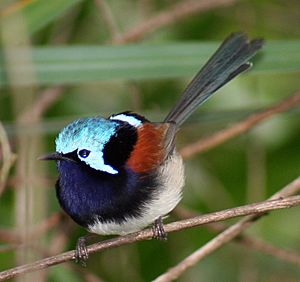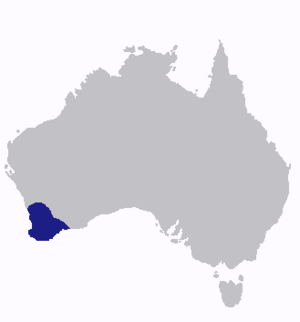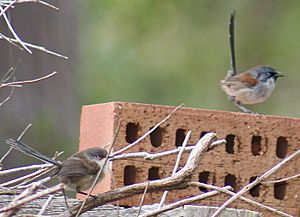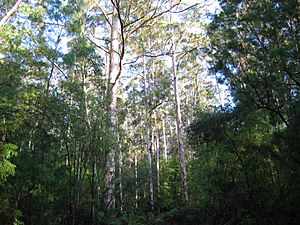Red-winged fairywren facts for kids
Quick facts for kids Red-winged fairywren |
|
|---|---|
 |
|
| Male in nuptial plumage, Margaret River, Western Australia |
|
| Conservation status | |
| Scientific classification | |
| Genus: |
Malurus
|
| Species: |
elegans
|
 |
|
| Approximate range/distribution map of the red-winged fairywren. Blue indicates presence. | |
The red-winged fairywren (Malurus elegans) is a small, colourful bird. It belongs to the Australasian wren family. This bird lives only in the southwestern part of Western Australia. It does not migrate, meaning it stays in the same area all year.
Male red-winged fairywrens look very different from females. During breeding season, males have bright, shiny blue and red feathers. Females and young birds are mostly grey-brown. This bird eats mostly insects. It lives in wet forests with lots of trees like karri trees. Like other fairywrens, it lives in small groups. These groups work together to raise their young.
Contents
About the Red-winged Fairywren
The red-winged fairywren was first described in 1837. This was done by a bird expert named John Gould. He gave it the name elegans, which means 'elegant' in Latin. At first, he thought it lived on Australia's east coast. Later, he corrected this to southwestern Australia.
Family Tree of Fairywrens
The red-winged fairywren is one of eleven species in the Malurus group. These birds are often called fairywrens. They are found in Australia and New Guinea. It is part of a group of four similar species. These are called the chestnut-shouldered fairywrens. The blue-breasted fairywren is its closest relative.
Fairywrens are not related to the "true" wrens found in other parts of the world. For a while, scientists thought they were related to flycatchers or warblers. But in 1975, they were placed in their own family, Maluridae. Later DNA studies showed they are related to honeyeaters. Other names for this bird include 'red-winged blue-wren'.
How Fairywrens Evolved
Scientists believe these fairywrens came from a northern area. About 2 million years ago, during a warm period, they spread south. The birds in the southwest became the red-winged fairywren. Later, cooler, drier times separated them. This caused them to become different species. Even though their living areas now overlap, they remain separate species.
What the Red-winged Fairywren Looks Like
The red-winged fairywren is about 15 centimetres (6 inches) long. It weighs between 8 and 11 grams (0.3 to 0.4 ounces). This makes it the largest of the fairywrens. Its tail is quite long, about 7.5 centimetres (3 inches). Its beak is long, narrow, and pointed. It is shaped well for finding and catching insects.
Male and Female Differences
Male red-winged fairywrens are very striking during breeding season. They have a shiny, silvery-blue crown and upper back. Their throat and neck are black. Their shoulders are bright red-brown. They have a long grey-brown tail and wings. Their belly is greyish-white. These bright colours are important for showing off during courtship.
Outside of breeding season, males look more like females. They are mostly grey-brown. But they might still have some blue or black feathers. Females and young birds are mostly grey-brown. Males have a black beak and a black area around their eyes. Females have a black beak, reddish-brown around their eyes, and a pale grey eye-ring.
Young males start to get black around their eyes by six weeks old. They begin to get their bright breeding feathers in their first breeding season. It might take them a year or two to get their full bright plumage.
Feather Changes and Colours
Both male and female birds change their feathers in autumn after breeding. Males then get their duller, non-breeding feathers. They change back to their bright breeding feathers in winter or spring. The blue feathers of the males are very shiny. They reflect ultraviolet light strongly. This means other fairywrens might see them as even brighter.
Bird Calls and Songs
Red-winged fairywrens use sounds to talk to each other. They sing to mark their territory and to defend it. They can tell different birds apart just by their song. Their main song is a high-pitched sound that lasts 1 to 4 seconds. Both males and females sing this song. They sing most often around sunrise and sunset.
When birds are looking for food, they make soft, repeating see-see-see sounds. This helps them stay in touch. If there is danger, they make a loud, sharp tsit sound as an alarm call.
Where the Red-winged Fairywren Lives
The red-winged fairywren lives in the wet southwestern part of Western Australia. You can find them from north of Perth down to the Margaret River area. They also live east to Albany. They are common in some areas. However, their numbers might be going down because of wetlands being drained.
They prefer the undergrowth of wet forests. These forests have trees like karri and jarrah. Older forests are not as good for them. But they seem to like areas that have been disturbed by logging. After a fire, they might disappear for about two years before returning. Pine and eucalyptus tree farms are usually not good homes for them. This is because they don't have enough undergrowth.
Within the forest, they like wet valleys and areas near rivers. The red-winged fairywren prefers wetter forests. Other similar fairywrens live in drier areas. This helps keep the species separate.
Red-winged Fairywren Behaviour
Red-winged fairywrens usually move by hopping. Both feet leave and land at the same time. They can also run very fast. Their long tail helps them balance. They usually hold their tail upright. Their short, round wings are good for short flights. But they are not good for flying long distances.
Courtship and Reproduction
The red-winged fairywren is a cooperative breeding bird. This means a pair or small group of birds lives together. They defend their territory all year. Their territories can be quite large. Groups usually have two to nine birds. This is one of the largest group sizes for fairywrens.
The main breeding pair stays together for life. If one partner dies, the other finds a new one. Often, this new partner is a helper bird from the group. Female helpers are very common in this species. Helpers feed the baby birds. This makes it easier for the breeding female. Groups with helpers raise more young birds each year.
Like other fairywrens, male red-winged fairywrens use bright petals to attract females. They have been seen carrying yellow or white petals. They show these petals to a female in their territory. Males also do a "face fan" display. They flare their blue ear tufts by raising their feathers. This is part of their courtship or when they are being aggressive.
The breeding season is shorter than for other fairywrens. It runs from October to December. The female builds the nest by herself. The nest is usually in thick plants, about 20 centimetres (8 inches) off the ground. It is a round or dome-shaped nest. It is made of grasses and spider webs. The inside is lined with finer materials.
They usually lay two or three eggs. The eggs are cream-white with reddish-brown spots. The female sits on the eggs alone for 14 to 15 days. Her long tail often gets bent in the small nest. This can be a sign that she is nesting. Almost all the eggs hatch successfully.
Baby birds are born red, naked, and blind. Their skin turns blue-grey as feathers grow. Their eyes open around the fifth day. All the group members help feed the young birds. They also remove waste from the nest. The young birds leave the nest after 11 to 12 days. They are fully feathered but cannot fly well yet. They stay hidden near the nest. Parents and helpers feed them for about a month after they leave the nest. Young birds often stay with their family group as helpers for a year or more. They become old enough to breed at one year old. But females usually don't breed until they are three years old. This is because there are not many open spots for breeding.
What They Eat
The red-winged fairywren is always busy looking for food. They search in low bushes and on the ground. They also go up into trees up to 5 metres (16 feet) high. They do this especially in late summer and autumn. The flaking bark of eucalyptus trees has many insects. But they don't stay in trees for long. This is because they are more open to predators there.
They eat many small creatures, mostly insects. They eat ants and beetles all year. During breeding season, they also eat spiders, bugs, and caterpillars. In spring and summer, they are active in short bursts. They sing while they look for food. Insects are easy to find then, so they can rest between meals. Groups often rest together during the hottest part of the day. In winter, food is harder to find. They spend all day looking for it. Ants are a very important food source in winter.
Dangers and Threats
Many animals prey on red-winged fairywren nests. These include Australian magpies, butcherbirds, laughing kookaburras, currawongs, crows, ravens, and shrike-thrushes. Introduced animals like red foxes, cats, and black rats also hunt them.
Like other fairywrens, they have a special trick to distract predators. It's called the "rodent-run display." The bird lowers its head, neck, and tail. It spreads its wings out and fluffs its feathers. Then it runs very fast while making a continuous alarm call. This makes the predator chase the bird instead of finding the nest.
Another display is the wing-fluttering display. This is seen when females respond to males. Young birds also do it when begging for food. The bird lowers its head and tail. It stretches out and shakes its wings. Its beak is open silently.
How Long They Live
Red-winged fairywrens live a long time for such small birds. About 78% of breeding males and 77% of breeding females survive each year. It's common for them to live to be 10 years old. The oldest known red-winged fairywren lived to be 16 years old!
Images for kids
See also
 In Spanish: Maluro elegante para niños
In Spanish: Maluro elegante para niños








